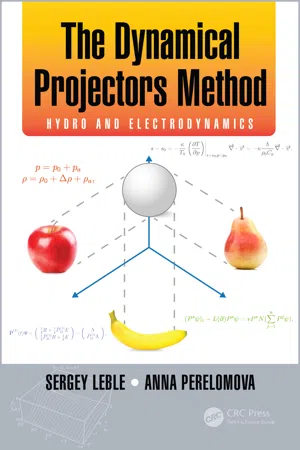
- 282 pages
- English
- ePUB (mobile friendly)
- Available on iOS & Android
About This Book
The dynamical projectors method proves to reduce a multicomponent problem to the simplest one-component problem with its solution determined by specific initial or boundary conditions. Its universality and application in many different physical problems make it particularly useful in hydrodynamics, electrodynamics, plasma physics, and boundary layer problems. A great variety of underlying mechanisms are included making this book useful for those working in wave theory, hydrodynamics, electromagnetism, and applications.
"The authors developed a universal and elegant tool – dynamical projector method. Using this method for very complicated hydro-thermodynamic and electrodynamics problem settings, they were able to get a lot of interesting analytical results in areas where before often just numerical methods were applicable."
—L. A. Bordag, University of Applied Sciences Zittau/Görlitz, Zittau, Germany
"The book is intended for professionals working in various fields of linear and nonlinear mathematical physics, partial differential equations and theoretical physics. The book is written clearly, and in my opinion, its material will be useful and easy to understand for professionals and for students familiar with ordinary and partial differential equations."
—Sergey Dobrokhotov, Russian Academy of Sciences, Moscow, Russia
Frequently asked questions
1 Introduction
Table of contents
- Cover
- Half Title
- Title Page
- Copyright Page
- Dedication
- Epigraphs
- Table of Contents
- List of Figures
- Preface
- Authors
- Chapter 1 Introduction
- Chapter 2 General Technique
- Chapter 3 One-Dimensional Problem in Hydrodynamics
- Chapter 4 Coupling of Sound with Vorticity: Acoustic Streaming
- Chapter 5 Projecting in Flows with Relaxation: Effects of Sound in Acoustically Active Fluids
- Chapter 6 Boundary Layer Problem: Acoustic and TollmiennSchlichting Waves
- Chapter 7 1D Electrodynamics
- Chapter 8 Metamaterials
- Chapter 9 Waves in Waveguides
- Chapter 10 Waves in 3D Space
- Index